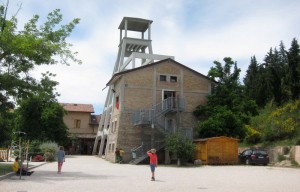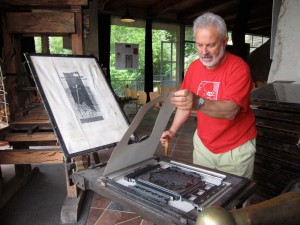A father-son team turned an abandoned sulfur mine into an educational agritourism “court” featuring the arts and machines of Man’s long history of communication.
LOC MINE, Italy — The retired art professor sitting at his 1884 Merganthaler Comet 300 linotype resembles a modern-day Johannes Gutenberg.
With his milky white hair and beard neatly trimmed, Egiziano Piersantini is demonstrating this massive metal letter-setting machine used by newspapers for most of the 20th century. A few yards away is a replica of Gutenberg’s 15th century printing press. Nearby are stones used for lithography, a stone-to-paper printing process that pre-dated Gutenberg for centuries.
These tools of human communication hark back to the beginning of human culture. They are at the heart of Piersantini’s agritourism retreat, La Corte della Miniera, or The Court of the Mine. The 63-year-old professor, who taught at Varese for 20 years, and his son, Michele, 43, bought and converted this sulfur mine abandoned in the 1930s to create an educational resort, complete with accommodations, workshops and historical printing technology.
Because human skill interacts with pliant materials such as stone, wash and paper, lithography is the most complete technique, “… é la tecnica piu complete,” Piersantini says, speaking through an interpreter.
Lithography is one of many techniques guests may learn at The Mine, from graphics and printing to papier mache and pottery. The rustic resort also hosts an outdoor pool or indoor Jacuzzi, traditional Marche dining at its own restaurant, mountain biking around the countryside and a choice of 34 finely furnished rooms, all priced within a student’s means.
The main attraction, however, is the variety of artistic workshops. Guests come year round from all over Italy, drawn by their interest in these arts and the antique machinery they may use to create them.
Piersantini intended just that when he and Michele opened the mine 12 years ago.
[pullquote]Our goal is not to be a hotel but to be a place for learning. People come here out of interest.[/pullquote]
“Our goal is not to be a hotel but to be a place for learning,” Michele said, the son also speaking through a translator. “People come here out of interest.”
An abandoned mine deep in the countryside outside Urbino is an unusual site for agritourism. The workshops are held in former furnaces. In operation since the 15th century, the “Pozzo Donegani,” or “Donegani Pit,” was abandoned in the 1930s with little or no documents or artifacts preserving its history.
In 1980, Persantini acquired the property and renovated it with his son for its official opening on March 7, 1990. He and Michele used to run an art printing business before the acquisition and intended to apply their knowledge of that to the resort.

The tower in the distance dates back to 1926 and was used until The Mine's final working days in the 1930's.
The father-son duo wanted to recreate the atmosphere of an Italian Renaissance court like that of the Duke of Urbino, Frederico Montefeltro, during the 15th century. In fact, Baldassere Castaglione’s The Courtier was written in 1528 as a guide to the proper mastery of various arts and behavior by ladies and gentlemen of the Duke of Urbino’s Court. Hence: The Court of the Mine, La Corte della Miniera.
Today, Michele manages The Mine, while his father sometimes leads workshops.
Keeping history and tradition intact to impart knowledge is their ultimate motivation for The Mine. It’s more old-fashioned than luxurious. From the food to the crafts, all the activities at The Mine are intended to engage guests in the local customs of the region.
Ironically enough, the farther people live from Urbino, the greater their interest in The Mine, Michele said. Locals barely visit. The Mine is most popular among students from all over Italy, with 18,000 students visiting with their schools per year. Families represent about 20 percent of all guests, and tend to visit during holidays or the summer months. Still, about 90 percent of all guests take advantage of the workshops, Michele added.
One recent weekday morning, 100 grade school children are scattered practicing art around the workshops, working with their hands in the same way their ancestors did. With brown smudges across a once plain surface and the rustle of paper humming in the air, children from an international school at Varese, in northern Italy, retrace works of early graffiti.
Posters of early alphabets in Arabic or cuneiform surround them in the tunnel-like room where sulfur was once extracted.
Learning to create early modes of handmade art and figurative text is something Piersantini feels brings people back to their roots.
[pullquote]We want to hand lithography over to young people, because lithography is the basis from which modern printing was born.[/pullquote]
“We want to hand lithography over to young people, because lithography is the basis from which modern printing was born,” he said.
Carlo Migani, 61, a teacher of serigraphy, or silk-screen writing, has been involved with The Mine since it was first established. Teaching here for the past seven years, he regards it as a historic preservation of human communication. Much of the equipment here has been lost or rendered obsolete, and few know how to assemble or dissemble them. The Mine has a repair workshop for this reason.
“This place is unique, I think, in Italy,” Migani said,.
The Mine has 170 printing presses from 1700 to today, most of them functional.
Piersantini counts his wealth by this collection.
“Nobody has got all this ensemble of art and lithography,” Piersantini said. “It is like Fort Knox for us. It is our bank.”
Neither the elder nor the younger Piersantini measures The Court of The Mine’s success by the euro. Besides being private about their profits, saying only that they make enough to get by, they do no marketing, other than directly contacting schools, and refrain from selling merchandise or souvenirs. It is not their priority, Michele said. People instead hear about The Mine by word of mouth and manufacture their own art to take home.
In much the same spirit, this green tourism location pours earnings right back into renovating more of The Mine. Michele calls it “eco-money.” The current priority is to expand the mine’s collection into a museum.
Michele’s spotted Jack Russell Terrier is weaving around him outside, which prompts him to make a contrast. Man, unlike Nana, feels the need to leave a mark, he says.
The museum will contain “il segno dell’uomo,” Michele said, “the man’s trace.”
Multimedia
